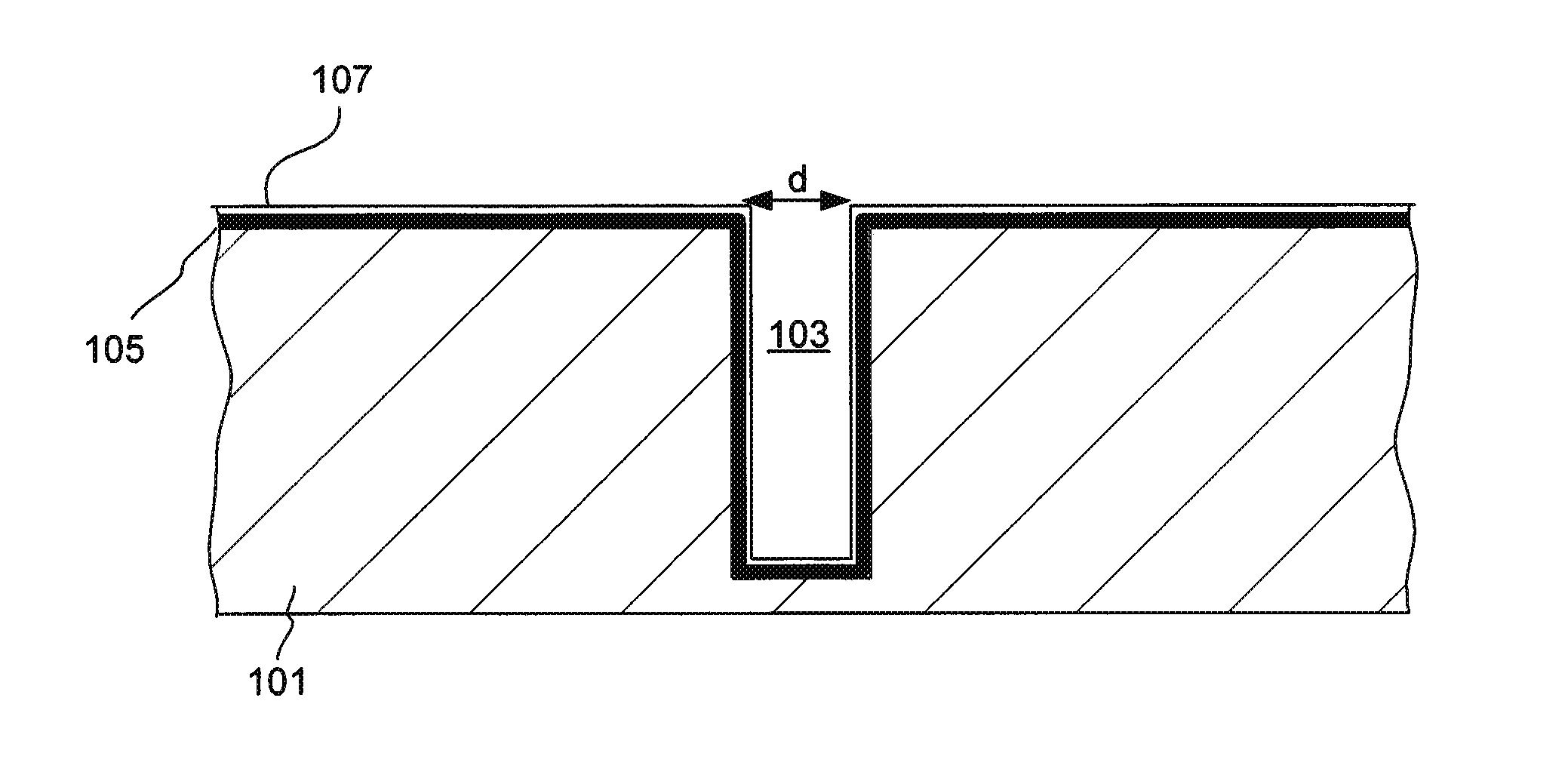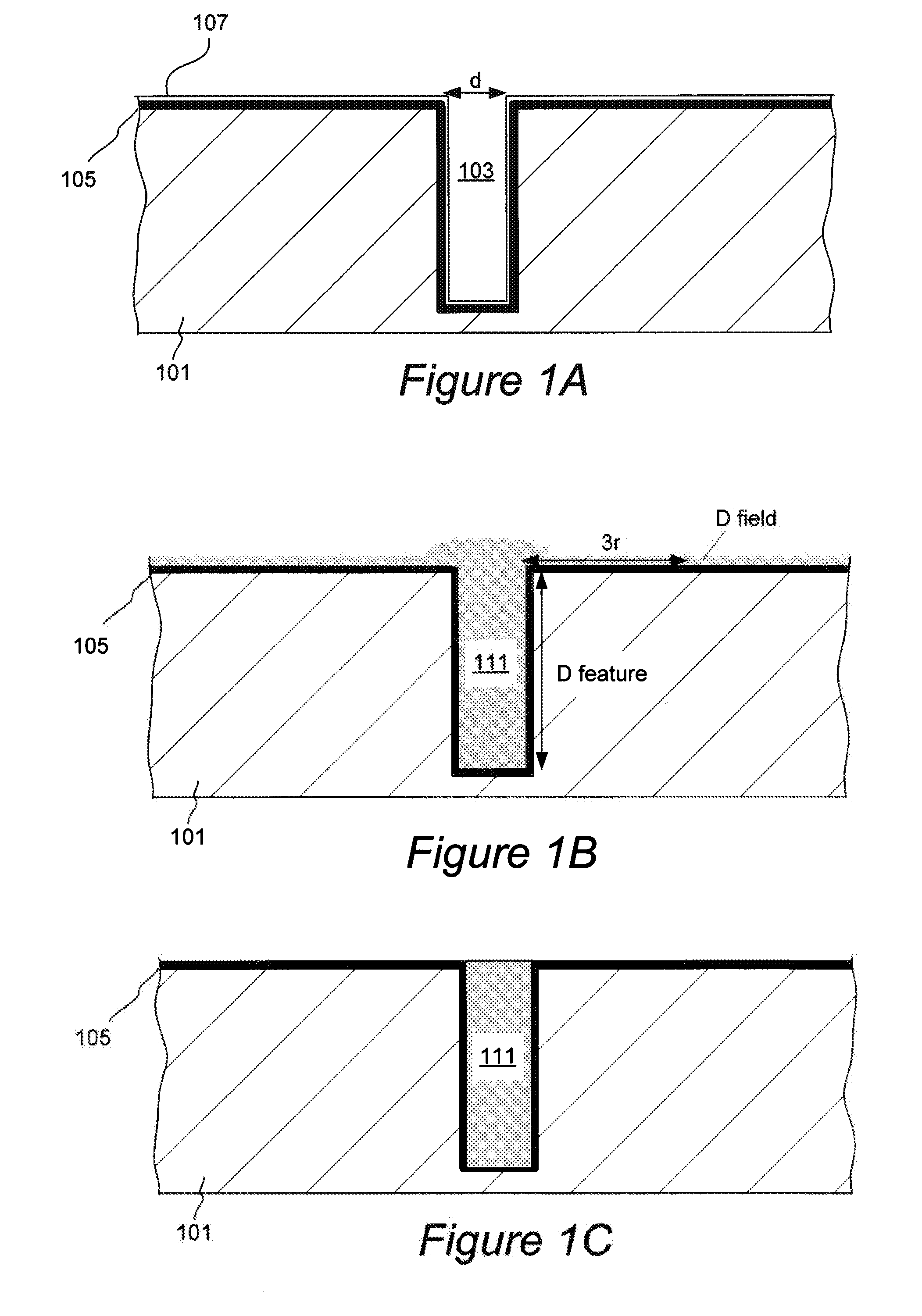Through silicon via filling using an electrolyte with a dual state inhibitor
a dual-state inhibitor and silicon via technology, applied in the direction of manufacturing tools, electric circuits, semiconductor/solid-state device details, etc., can solve the problems of difficult deposition of copper into such structures, complex and expensive precursors, limited step coverage, etc., to achieve the effect of improving speed and control
- Summary
- Abstract
- Description
- Claims
- Application Information
AI Technical Summary
Benefits of technology
Problems solved by technology
Method used
Image
Examples
example 1
Electroplating with an Electrolyte Containing Thonzonium Bromide DSI
[0124]The preferred plating conditions for a plating electrolyte containing thonzonium bromide, were determined by running a series of CV experiments. The chemical structure of thonzonium bromide is shown below:
[0125]Prior to performing CV experiments, a platinum rotating disk working electrode (RDE) surface was plated with copper from an additive-free electrolyte, containing copper sulfate (at 70 g / L copper ion concentration) and sulfuric acid (at 20 g / L H2SO4 concentration). The exposed electrode surface prior to each CV experiment was a fresh copper surface. Plating of fresh copper layer was performed at a current density of 5 mA / cm2 to deposit about 5000 Å over the 0.1965 cm2 Pt disk electrode. After each CV experiment, all of copper was etched and removed from the Pt RDE, and fresh copper metal was redeposited thereafter prior to subsequent CV test.
[0126]Unless otherwise noted, CV experiments were performed at ...
example 2
Electroplating with an Electrolyte Containing BDHAC DSI
[0136]The preferred plating conditions for a plating electrolyte containing BDHAC, were determined by running a series of CV experiments. The chemical structure of BDHAC is shown below.
[0137]The Pt RDE electrode was prepared for CV experiments, in the same manner as was described in Example 1. The sweep rate and reference electrode used in CV experiments were the same as used in Example 1.
[0138]The electrolytes used in CV experiments contained copper sulfate (20-70 g / L Cu1+), sulfuric acid (0-100 g / L H2SO4), BDHAC (5-50 ppm) and, optionally, HCl as a source of chloride additive (0-50 ppm). The rotation rate of the electrode was varied from 30 to 120 ppm.
[0139]It was determined by obtained CV curves, that BDHAC maintains good DSI switching behavior at low-acid concentrations, but loses its switching behavior at high acid concentrations (at 100 g / L H2SO4 and above). While not being bound by the particular theory, it is believed th...
example 3
Electroplating with an Electrolyte Containing DVF 200 C
[0147]The preferred plating conditions for a plating electrolyte containing DVF 200 C, were determined by running a series of CV experiments.
[0148]The Pt RDE electrode was prepared for CV experiments, in the same manner as was described in Example 1.
[0149]The electrolytes used in CV experiments contained copper sulfate (20-70 g / L Cu2+), sulfuric acid (20-100 g / L), DVF 200 C (5-30 mL / L) and, optionally, HCl as a source of chloride additive (0-50 ppm). The rotation rate of the electrode was varied from 30 to 120 ppm.
[0150]It was determined by obtained CV curves, that DVF 200 C maintains good DSI switching behavior only at relatively high concentrations of DVF 200 C, but loses its switching behavior at low additive concentrations.
[0151]Exemplary conditions determined to be suitable are as follows: copper sulfate (50-70 g / L Cu2+), sulfuric acid (20-100 g / L), DVF 200 C (10-20 mL / L) and, optionally, HCl as a source of chloride additiv...
PUM
| Property | Measurement | Unit |
|---|---|---|
| width | aaaaa | aaaaa |
| concentration | aaaaa | aaaaa |
| diameter | aaaaa | aaaaa |
Abstract
Description
Claims
Application Information
 Login to View More
Login to View More - R&D
- Intellectual Property
- Life Sciences
- Materials
- Tech Scout
- Unparalleled Data Quality
- Higher Quality Content
- 60% Fewer Hallucinations
Browse by: Latest US Patents, China's latest patents, Technical Efficacy Thesaurus, Application Domain, Technology Topic, Popular Technical Reports.
© 2025 PatSnap. All rights reserved.Legal|Privacy policy|Modern Slavery Act Transparency Statement|Sitemap|About US| Contact US: help@patsnap.com



